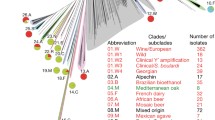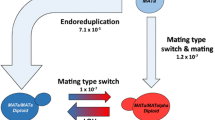Summary
Thirteen independent populations of Saccharomyces cerevisiae (nine haploid and four diploid) were maintained in continuous culture for up to approximately 1000 generations, with growth limited by the concentration of organic phosphates in medium buffered at pH 6. Analysis of clones isolated from these populations showed that a number (17) of large-scale chromosomallength variants and rearrangements were present in the populations at their termination. Nine of the 16 yeast chromosomes were involved in such changes. Few of the changes could be explained by copy-number increases in the structural loci for acid phosphatase. Several considerations concerning the nature and frequency of the chromosome-length variants observed lead us to conclude that they are selectively advantageous.
Similar content being viewed by others
References
Adams J, Hansche PE (1974) Genetics 76:327–338
Adams J, Oeller PW (1986) Proc Natl Acad Sci USA 83:7124–7127
Adams J, Paquin C, Oeller PW, Lee LW (1985) Genetics 110:173–185
Andersen N, Thill GP, Kramer RA (1983) Mol Cell Biol 3:562–569
Anderson RP, Roth JR (1977) Annu Rev Microbiol 31:473–505
Carle GF, Olson MV (1984) Nucleic Acids Rev 12:5647–5664
Carle GF, Olson MV (1985) Proc Natl Acad Sci USA 82:3756–3760
Chu G, Vollrath D, Davis RW (1986) Science 234:1582–1585
Crow JF, Kimura M (1965) Amer Nat 99:439–450
Francis JC, Hansche PE (1972) Genetics 70:59–73
Francis JC, Hansche PE (1973) Genetics 74:259–265
Hansche PE (1975) Genetics 79:661–674
Hansche PE, Beres V, Lange P (1978) Genetics 88:673–687
Helling RB, Vargas CN, Adams J (1987) Genetics 116:349–358
Hinnen A, Bajwa W, Meyhack B, Rudolph H (1987) Molecular aspects of acid phosphatase synthesis in Saccharomyces cerevisiae. In: Torriani-Gorini A, Rothmann FG, Silver S, Wright A, Yagil E (eds) Phosphate metabolism and cellular regulation in microorganisms. American Society for Microbiology, Washington DC, pp 56–62
Kaplan NL, Hudson RR, Langley CH (1989) Genetics 123:887–889
Kouprina NY, Pasina OB, Nikolaishwili NT, Tsouladze AM, Larionov VL (1988) Yeast 4:257–269
Krawiec S, Riley M (1990) Microbiol Rev 54:502–539
Kubitschek HE (1974) Symp Soc Gen Microbiol 24:105–130
Link AJ, Olson MV (1991) Genetics 127:681–698
Maniatis T, Fritsch EF, Sambrook, J (1982) Molecular cloning — a laboratory manual. Cold Spring Harbor Laboratory, Cold Spring Harbor, New York
Maruyama T, Birky CW Jr (1991) Genetics 127:449–451
Maynard Smith J, Haigh J (1974) Genet Res 23:25–35
Mikus MD, Petes TD (1982) Genetics 101:369–404
Mortimer RK, Schild D (1985) Microbiol Rev 49:181–212
Muller HJ (1932) Amer Nat 68:118–138
Newlon CS (1988) Microbiol Rev 52:568–601
O'Brien SJ, Seuanez HN, Womack JE (1988) Annu Rev Genet 22:323–351
Ornston LN, Neidle EL, Houghton JE (1990) Gene rearrangements, a force for evolutionary change; DNA sequence rearrangements, a source of genetic constancy (1990) In: Drlica K, Riley M (eds) The Bacterial chromosome. ASM Publications, Washington D.C. pp 325–333
Paquin C, Adams J (1982) Curr Genet 6:21–24
Paquin CE, Adams J (1983) Nature 302:495–500
Paquin CE, Dorsey M, Crable S, Sprinkel M, Sondej M, Williamson VM (1992) Genetics 130:263–271
Petes PD, Hill CW (1988) Annu Rev Genet 22:147–168
Rigby PWJ, Burleigh BD, Hartley BS (1974) Nature 251:200–204
Riley M (1984) Arrangement and rearrangement of bacterial genomes. In: Mortlock, RP (ed) Microorganisms as model systems for studying evolution. Plenum Press, New York, pp 285–316
Riley M (1985) Discontinuous processes in the evolution of the bacterial genome. In: Hecht, MK, Wallace, B and Prance, G (eds) Evolutionary Biology. Plenum Press, New York, pp 1–36
Sonti RV, Roth JR (1989) Genetics 123:19–28
Steensma HY de, Jonge P de, Kaptein A, Kaback DB (1989) Curr Genet 16:131–137
Sugawara N, Szostak JW (1983) Proc Natl Acad Sci USA 80:5675–5679
Venter U, Horz W (1989) Nucleic Acids Res 17:1353–1369
Vollrath D, Davis RW (1987) Nucleic Acids Res 15:7865–7876
Author information
Authors and Affiliations
Additional information
Communicated by C. W. Birky, Jr.
Rights and permissions
About this article
Cite this article
Adams, J., Puskas-Rozsa, S., Simlar, J. et al. Adaptation and major chromosomal changes in populations of Saccharomyces cerevisiae . Curr Genet 22, 13–19 (1992). https://doi.org/10.1007/BF00351736
Received:
Accepted:
Issue Date:
DOI: https://doi.org/10.1007/BF00351736




